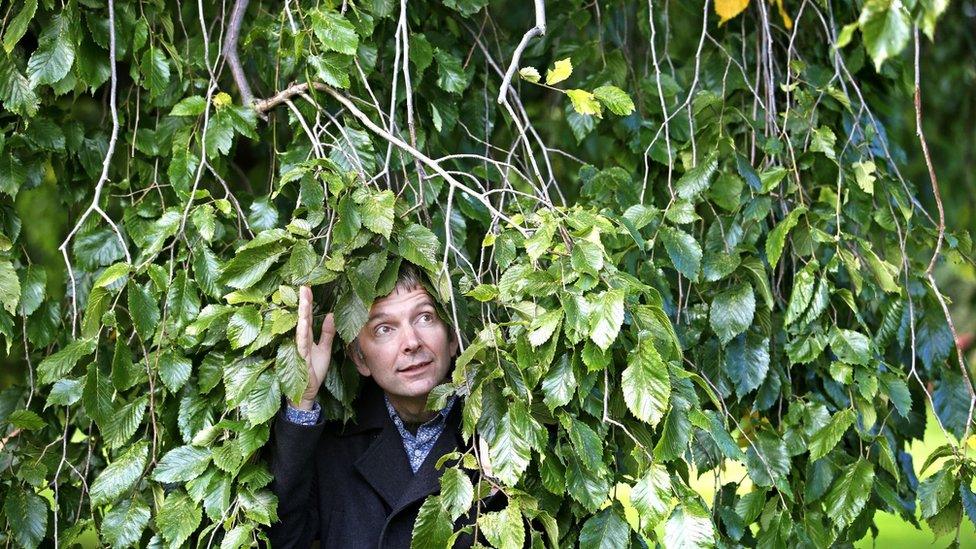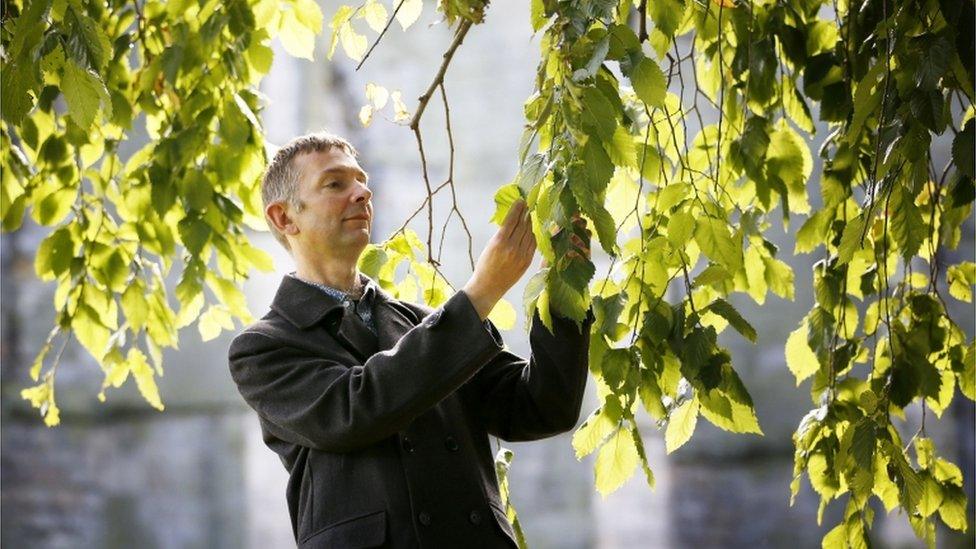'Extinct' elms found in Queen's garden in Edinburgh
- Published
The trees were discovered at the Queen's official residence in Scotland
Trees believed to have been extinct in Britain have been discovered at the Queen's official residence in Scotland.
The two 100ft Wentworth elms have been identified in the Queen's garden at the Palace of Holyroodhouse in Edinburgh.
Despite being among the most photographed trees in the garden, the breed was only identified during a recent tree survey.
Tree experts are now looking into ways of propagating the rare specimens, Ulmus Wentworthii Pendula.
'Removing diseased elms'
Dr Max Coleman, of the Royal Botanic Garden Edinburgh (RBGE), told the BBC's Good Morning Scotland radio programme: "That's the most striking thing about this story. It seems very odd on the face of it that these massive trees, that are probably the most photographed trees in the grounds of the palace, have gone unrecognised until now.
"I think the reason is that firstly they were never common, these Wentworth elms. If you pull your tree book off the shelf to try and look them up, you won't find Wentworth elm listed in the books.
"Secondly, and probably more importantly, there are relatively few people these days that are familiar with elm trees and unfortunately the reason for that is that since the 1970s we've lost somewhere between 25 and 75 million elms across the UK as a whole due to Dutch Elm Disease."

Dr Coleman said affirmative action by the local council had probably preserved the trees.
"It is very likely the only reason these rare elms have survived is because City of Edinburgh Council has been surveying and removing diseased elms since the 1980s.
"Without that work many more of the thousands of elms in Edinburgh would have been lost.
"The success of this programme may be partly demonstrated in the way two rare trees have been preserved."
The trees grow with a "weeping" appearance and have large glossy leaves.
Scientists said the Wentworth elm was most likely introduced to cultivation in the late 19th century but it was thought to have been wiped out in the Dutch elm disease epidemic during the late 20th century.

While the palace trees have been identified, it is not yet clear where the two specimens came from.
Curators and archivists at the royal household and RBGE are now working to find out more about their origins.
One theory is that the trees arrived at Holyrood from RBGE and survived while their Botanic Garden sibling died.
Archives already show that three Wentworth elms arrived at the Botanic Garden from Germany in 1902, after which all subsequent records refer to a single tree at the garden. The single Wentworth elm died in 1996 when it succumbed to Dutch elm disease.
Dr Coleman said: "It is very tempting to speculate that the Wentworth elms at the palace are the two missing trees from RBGE.
"There is anecdotal evidence that the young trees could have come in to RBGE, then been grown-on before planting-out in their final positions.

Dr Max Coleman examines the leaves on one of two 100ft Wentworth elms
"Certainly, there was a close relationship between the palace and the garden in the early 20th century and the head gardener at Holyrood, William Smith, had trained here.
"Although we have no record here of elms going out, we know that a large number of ivy plants went from here to Holyrood to plant round the abbey ruins."
Alan Keir, Holyrood Park and gardens manager for Historic Environment Scotland (HES), which maintains the palace gardens, said: "When RBGE got in touch to ask if we could facilitate a walk round the gardens to find cultivars for propagation, we were happy to help - but certainly didn't expect them to find these rare specimens hidden in plain sight.
"The HES gardens team have undertaken careful maintenance of these specimens over the past several years, including crown reduction and limb bracing works, and we're proud to help look after the only remaining examples of these trees in Britain."